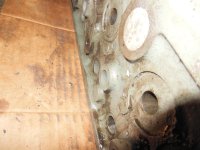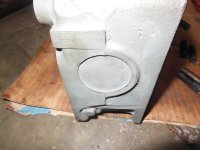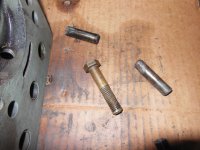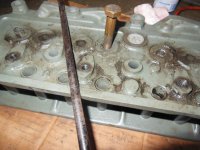-
 Hi Guest!
Hi Guest!
If you appreciate British Car Forum and our 25 years of supporting British car enthusiasts with technical and anicdotal information, collected from our thousands of great members, please support us with a low-cost subscription. You can become a supporting member for less than the dues of most car clubs.
There are some perks with a member upgrade!**Upgrade Now**
(PS: Subscribers don't see this gawd-aweful banner

Tips
- We have a special forum called "Member Articles" where you can submit actual articles for consideration for publication. Learn More
- Don't have an Avatar? If not, your avatar will default to the 1st character in your username. Go into "Account Details" to change your Avatar.
- Some basic forum navigation info: click
Hey - did you know if you click on the title of a thread it will take you to the first unread post since you last visited that thread?
- Hey Guest - Is your British Car Club in our Clubs database? If not, send me a PM - Basil

- Looking for a local club? Click the "Clubs" tab above and browse hundreds of clubs world-wide.
- Add Android or iPhone APP: click
- Did you know - any picture or video you add in your posts in any marque-specific forum will also get added to the Media Gallery automatically.
- A few more tips about posting and replying: click
- Hey there Guest - be sure to keep your profile page up to date with interesting info about yourself: learn more
- More tips and tricks on Posting and Replying: click
 STOP!! Never post your email address in open forums. Bots can "harvest" your email! If you must share your email use a Private Message or use the
STOP!! Never post your email address in open forums. Bots can "harvest" your email! If you must share your email use a Private Message or use the  smilie in place of the real @
smilie in place of the real @
- Want to mention another member in a post & get their attention? WATCH THIS

- So, you created a "Group" here at BCF and would like to invite other members to join? Watch this!
- Hey Guest - A post a day keeps Basil from visiting you in the small hours and putting a bat up your nightdress!
- Hey Guest - do you know of an upcoming British car event?
 Pretty Please - add it to our Events forum(s) and add to the calendar! >> Here's How <<
Pretty Please - add it to our Events forum(s) and add to the calendar! >> Here's How << 
- Hey Guest - you be stylin'
Change the look and feel of the forum to fit your taste. Check it out
- If you run across an inappropriate post, for example a post that breaks our rules or looks like it might be spam, you can report the post to the moderators: Learn More
- If you would like to try some different "looks" or styles for the site, scroll to the very bottom, on the left and click the Style Selector.
You are using an out of date browser. It may not display this or other websites correctly.
You should upgrade or use an alternative browser.
You should upgrade or use an alternative browser.
TR2/3/3A Rebuilding a cylinder head
- Thread starter sp53
- Start date
CJD
Yoda
Offline
Unfortunately the iron guide and iron head will expand the same. If you shoot a coolant through the guide hole, you could set up a gradient where the guide shrinks slightly before the cool is transferred into the head. That may work in removal. Cooling the new guid before insertion will definitely help with the install.
For height, put a valve you plan to use in the guide hole and install the spring retainer and keepers. Measure how much room you have between the spring retainer to the top of the head, and then subtract the lift you will be using from the cam and rockers. That is the highest you can install the guide. I usually shoot for about .1" extra clearance, just in case you ever get valve float, although that comes from my old high performance days. The TR engines are not that high performance to worry!?!
For height, put a valve you plan to use in the guide hole and install the spring retainer and keepers. Measure how much room you have between the spring retainer to the top of the head, and then subtract the lift you will be using from the cam and rockers. That is the highest you can install the guide. I usually shoot for about .1" extra clearance, just in case you ever get valve float, although that comes from my old high performance days. The TR engines are not that high performance to worry!?!
Offline
According to fairly reliable sources, including Boston University Physics Dept., a hole in iron will expand just as if it contained the surrounding material. I'll take my lickin and admit I'm wrong.
Bob
Bob
Removing the exhaust valves was not difficult. I used a brass bolt and drove them out with a few whacks. The brass bolt was nice because I used the head of the bolt at first then when the guide went below grade into the hole, I flipped the bolt over.
The paint the PO put on this head is something I believe called green death primmer by old body shops in the day. At first my plan was to drop the head in one of those white bucks half filled with gasoline and let that sit for a while and see if that would take it off, but now I might leave it on the head and glass bead the head where it needs to it. There are just a lot of carbon deposits in the intake ports.
The plugs on the top of the head and end look newly replaced for the head, but difficult to say for sure, but they look good to me. In addition, the PO said he had the head magnafluxed( whatever that means) I guess that checks for crakes. I usually do not believe what I hear from a seller, but I like this guy. He was not a BSer.
Now I plan to buy some valves and guides from Moss. I have those other heads with springs plus I saved a lot of springs from other head work I have had done. I think the last time I spent 500.00+ so I am ok with learning.
Steve
The paint the PO put on this head is something I believe called green death primmer by old body shops in the day. At first my plan was to drop the head in one of those white bucks half filled with gasoline and let that sit for a while and see if that would take it off, but now I might leave it on the head and glass bead the head where it needs to it. There are just a lot of carbon deposits in the intake ports.
The plugs on the top of the head and end look newly replaced for the head, but difficult to say for sure, but they look good to me. In addition, the PO said he had the head magnafluxed( whatever that means) I guess that checks for crakes. I usually do not believe what I hear from a seller, but I like this guy. He was not a BSer.
Now I plan to buy some valves and guides from Moss. I have those other heads with springs plus I saved a lot of springs from other head work I have had done. I think the last time I spent 500.00+ so I am ok with learning.
Steve
Attachments
Thanks Bob I can see it now; the hole would grow because the valve guide with a smaller different metal would stretch with the head because the metal is stuck that firmly. ( they might not think that, minds eye thing)My thoughts are the smaller metal of the valve guide would cool quicker and pull away from the larger casting because the casting cooled slower because its size retains the heat.
Bob I did not use heat on those valves guides because I forgot to; it was when I say this email I remembered to heat them. Just for clarity no heated needed only the brass 4 inch bolt, and wd40.
Steve
Bob I did not use heat on those valves guides because I forgot to; it was when I say this email I remembered to heat them. Just for clarity no heated needed only the brass 4 inch bolt, and wd40.
Steve
Offline
My earlier thought focused on forces sort of perpendicular to the circumference pushing the circumference "in". Boston University's simple explanation is that the circumference gets longer.
Bob
Bob
Hi guys I am looking to see if anyone has an opinion on valve guide material to use in this tr3 head rebuild. I guess there is bronze or cast iron guides and I assume they can be mixed. I see the 3/8 and 5/16 size guides difference, but do not know about the different material. The bronze sounds better in the readings. I think I can get 3/8 cast iron valves guides for the exhaust valves from Rimmers bro. and that is what the head had in it.
Steve
Steve
I rebuilt my head during COVID from parts available on Rimmer Bros. I got a cheap OEM-sized valve set (from China?), and some OEM-style cast iron guides. They were not expensive. I had a shop press out the bronze alloy guides that had been installed by someone else because they were too hard and had scored the shafts of the valves I wanted to replace. I also had the shop tank clean and bead-blast the head to make it shiny again. Installing the new guides was easy with a hammer and a properly-sized installation tool that was less than 20 bucks online. It looked like a fancy nail-set. I used a spacer that I cut to get the heights right- they do not need to be perfect. I checked each guide with its valve for feel-fit and discovered that I needed to ball-hone a couple of them out, to loosen them up a bit. Then I hand-seated each valve in its new home with 2 grits of paste and one more pass with no paste. It performs great and the whole process cost only a couple-hundred bucks. These engines are not space ships- there seems to be a decent amount of room for home-mechanic variation (error!). Just my own experience- good luck!
I admire the effort but you cant produce a good 3 angle valve seat without the proper equipment,
If you really want to do this yourself look at the New way cutters and guide pins.You can buy one cutter and guide pin,not a whole set,and the turn carbide cutters by hand.
If you got away with just valve grinding compound you must have had very good seats to start,And using a valve only address one angle,while putting a groove in the valve face.
Your stems were most likely scored from lack of clearance,not a to hard guide
And if a shop told me they used ball hones to size guides I would run away.
There's is no more room for the home mechanics variation than a shops.
Glad it worked for you ,but with labor the same , skimp on the machining is IMHO not recommended.
Tom
If you really want to do this yourself look at the New way cutters and guide pins.You can buy one cutter and guide pin,not a whole set,and the turn carbide cutters by hand.
If you got away with just valve grinding compound you must have had very good seats to start,And using a valve only address one angle,while putting a groove in the valve face.
Your stems were most likely scored from lack of clearance,not a to hard guide
And if a shop told me they used ball hones to size guides I would run away.
There's is no more room for the home mechanics variation than a shops.
Glad it worked for you ,but with labor the same , skimp on the machining is IMHO not recommended.
Tom
Last edited:
CJD
Yoda
Offline
Hey Steve...
In a street engine, iron guides will work fine and last the longest. If you go to bronze, you have to open up the valve stem clearance at least .001 to .002", as they will tend to scuff the stems if you don't, and often stick if the clearance is as tight as the manual recommends with bronze. Iron guides can be tight enough that you need no other seals than the spring retainers to limit oil usage through the guides. If you go bronze, you will use a bit more oil, and it may even be a good idea to use special intake guide seals.
As you can tell, iron guides are simple and easy. Bronze guides take a bit more planning for clearance and seals...and are usually used on very high spring loaded valve trains instead of stock style engines.
If you replace the guides, it is mandatory to re-cut the valve seats. Any time the guide is replaced, the valve stem center is altered a few thousands in random direction's. If you try to change guides and then just put the valve back in, the valve will hit crooked every time it sets down. This will wear the new guide and make the seat oval...both not good things! With new guides, you must grind or cut the new seats to center concentrically with the guides.
Hope this explains why...?!?
In a street engine, iron guides will work fine and last the longest. If you go to bronze, you have to open up the valve stem clearance at least .001 to .002", as they will tend to scuff the stems if you don't, and often stick if the clearance is as tight as the manual recommends with bronze. Iron guides can be tight enough that you need no other seals than the spring retainers to limit oil usage through the guides. If you go bronze, you will use a bit more oil, and it may even be a good idea to use special intake guide seals.
As you can tell, iron guides are simple and easy. Bronze guides take a bit more planning for clearance and seals...and are usually used on very high spring loaded valve trains instead of stock style engines.
If you replace the guides, it is mandatory to re-cut the valve seats. Any time the guide is replaced, the valve stem center is altered a few thousands in random direction's. If you try to change guides and then just put the valve back in, the valve will hit crooked every time it sets down. This will wear the new guide and make the seat oval...both not good things! With new guides, you must grind or cut the new seats to center concentrically with the guides.
Hope this explains why...?!?
Thanks you guys for your help. Both you guys suggest the cast iron and they are cheaper than the bronze ones and sound better and easier to work with. I think I will go with the cast iron.
I like the idea of the 3/8 exhaust valve because it sounds stronger, but heck I do not know. All those collars deals I have are for the heads that have 3 exhaust valves.
Thanks John for that visualization. I see the difficulty clearer how the guide, valve, and the seat need to come together. Getting those 3 pieces to come together and seal up tight for compression and oil consumption does not sound easy. Anyways sounds difficult to accomplish a 100% proper rebuilding of a head without some special equipment.
I wonder what a diy guy could do to get a homemade valve job if the seats and guides where left in place. I was going to do exactly what Mike did.
We did do valve jobs in high school or I should say we removed the heads from some teachers cars and a few handpicked kids would finish them.
I have put about 10K on tr3 in the last 15years and I am 70 so there is also that to consider.
I remember people saying the guides need to be replaced because the lead was taken out of the fuel and engine burned hotter and needed a different harder valve seat to deal with the heat , but was not sure how important that all was. But I always paid for it at the machine shop.
steve
I like the idea of the 3/8 exhaust valve because it sounds stronger, but heck I do not know. All those collars deals I have are for the heads that have 3 exhaust valves.
Thanks John for that visualization. I see the difficulty clearer how the guide, valve, and the seat need to come together. Getting those 3 pieces to come together and seal up tight for compression and oil consumption does not sound easy. Anyways sounds difficult to accomplish a 100% proper rebuilding of a head without some special equipment.
I wonder what a diy guy could do to get a homemade valve job if the seats and guides where left in place. I was going to do exactly what Mike did.
We did do valve jobs in high school or I should say we removed the heads from some teachers cars and a few handpicked kids would finish them.
I have put about 10K on tr3 in the last 15years and I am 70 so there is also that to consider.
I remember people saying the guides need to be replaced because the lead was taken out of the fuel and engine burned hotter and needed a different harder valve seat to deal with the heat , but was not sure how important that all was. But I always paid for it at the machine shop.
steve





